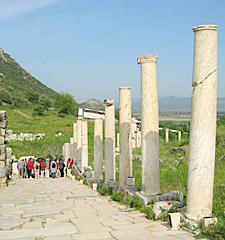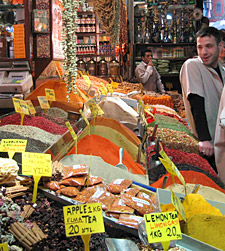"I want you to know brothers and sisters how much I am struggling for you and for those at Laodicea, and for all who have not met me personally. My purpose is that they may be encouraged in heart and united in love, so that they may have the full riches of complete understanding, in order that they may know the riches of God, namely, Christ, in whom are hidden all the treasures of wisdom and knowledge."
Hearing those words, written so long ago to the church at Colossae, in the very area it would have been read by its recipients, was something quite special. Colossae itself is unimpressive, as little remains today other than two tells in the location of the old city, and what is there is covered in crops. Still, it remains a powerful reminder of the city that once was, and the new church established in it so long ago.
 After leaving Colossae behind we traveled on to Laodicea. The church that was neither hot nor cold, but instead an unpalatable lukewarm had been located in a relatively large town. Excavations were still underway, and only part of the town centre and nearby theatre were unearthed. The slabs of stone making up the central city street bore the same grooves from years of passing chariots as had the streets of Psidian Antioch. The theatre was also typical of those we had seen, with rows of hard marble seats climbing steeply up 30 rows. This one however was built into the side of a natural hill, and was not a stand alone structure as had been the others, making it a little less of an architectural feat.
After leaving Colossae behind we traveled on to Laodicea. The church that was neither hot nor cold, but instead an unpalatable lukewarm had been located in a relatively large town. Excavations were still underway, and only part of the town centre and nearby theatre were unearthed. The slabs of stone making up the central city street bore the same grooves from years of passing chariots as had the streets of Psidian Antioch. The theatre was also typical of those we had seen, with rows of hard marble seats climbing steeply up 30 rows. This one however was built into the side of a natural hill, and was not a stand alone structure as had been the others, making it a little less of an architectural feat.
The hightlight of the day however was a visit to the city of Hieropolos. Built by Eumenes II, king of Pergamum, in around 190 BC, in honour of his wife, the city was enormous. It took us well over an hour to walk from end to end, and on the way there were many sights to see. At the very eastern end was a main gate cut into the large city wall, one of a series of gates every 100 metres along the perimeter. On the southern boundary of the city was a steep cliff, covered in weathered deposits of minerals, cascading over the edge of the cliff and down into the valley. The result of countless centuries of hot thermal springs bubbling out of the mountainside, it was over 150 metres wide and several hundred metres high. It had been clearly visible some 10 kilometres in the distance from the hilltop of Colosse, and up close it was impressive in its magnitude. Stalactites hung on the precipice, slowly building the wall up ever higher. Going past the massive mineral deposits was another impressive theatre, a testament to the building prowess of the Greeks. Subsequently taken over by the Romans, it flourished and later was home to another part of the early church. A large ruined Byzantine church lay alongside an equally ruinous Temple of Apollo, little more than a pile of crumbling columns and haphazard paving stones. On the outskirts of Hieropolos was one of the best preserved necropoli of Asia Minor. Several hundred sarcophagi of various sizes were littered about an area of a few hundred square metres, alongside the Bath of Hadrian. While it seems odd to us for a bathhouse to be near a cemetery, it was to allow an opportunity for dusty tired travelers to clean up before entering the city proper.
After Hieropolos we drove a short distance to Parmakkula, with its marvelous hot springs. They were unimaginably good after several grueling days on the road, with the water at a decidedly refreshing 43 degrees. Some less sedate members of the group took advantage of the near freezing outdoor swimming pool to chill off before jumping into the springs, back into the pool and then into the springs again. One wonders if all the travel had got to them at last and totally messed with their heads.
The next day was the Aprodisias, with its massive Temple of Aprodite. Large sections of the city still stand, and it is easy to picture the splendour of the temple and surrounding city as it would have looked when originally built. Early foundations of the city date back to 2000 BC, with the temple and main city dating back to the 8th century BC. A favourite stop of tourists of the day to pay their respect to the goddess, in the Byzantine era the temple was converted to a church, and carvings of crosses and other Christian symbols can still be clearly seen in the Ionic columns.
The highlight of Aphrodisias was a massive stadium, stretching almost 300 metres in length and over 50 metres wide. Seating 30,000, it would have been a true spectacle to see the races and wrestling of the day along the course of the stadium. The sound of the roaring crowd must have been immense and deafening, with the stone seating providing a natural boost to the acoustics. Now partly overgrown and with chipped and crumbling seats it is a shadow of its former glory, but nonetheless still breathtaking in its sheer size and scale.
 Lunch that day was probably the best meal of the tour - a fabulously tasty pide, kind of a Turkish pizza, with mince, tomato, chili and other spices on a seriously crunchy bread base. Spicy and sweet tasting at the same time it was a filling meal, matched only by the unbelievably good baklava which was a perfect balance between crushed nuts and pastry with just the right amount of sugar syrup. Nursing a Turkish coffee with enough oomph to stop a herd of elephants, after lunch we pondered the maxim that ‘an army marches on its stomach’ and decided it definitely had significant merit.
Lunch that day was probably the best meal of the tour - a fabulously tasty pide, kind of a Turkish pizza, with mince, tomato, chili and other spices on a seriously crunchy bread base. Spicy and sweet tasting at the same time it was a filling meal, matched only by the unbelievably good baklava which was a perfect balance between crushed nuts and pastry with just the right amount of sugar syrup. Nursing a Turkish coffee with enough oomph to stop a herd of elephants, after lunch we pondered the maxim that ‘an army marches on its stomach’ and decided it definitely had significant merit.
Suitably fortified we ventured out to Miletus, an ancient city dating back to 800 BC or so and home to some of the best known pre-Socratic philosophers such as Thales. Housing another large theatre, there were some unusual inscriptions on the fifth row of seats. Paul Barnett challenged the Greek graduates amongst the group to translate the inscription, but no one dared take up the invitation given the company kept in the group. Relenting, Paul told us that it was a reservation sign, stating ‘this place reserved for the Jews and God-fearers’. Moving on from the theatre we wandered around a city older than the new testament and the later parts of the Old Testament, laid out in typical Hellenistic fashion. Collapsing on to the bus after a long day of driving and two magnificent sites, we headed off to the hotel and some much needed sleep. Tomorrow we get to sleep in to the deliciously late hour of 6.30am! Much better than the previous 5.00 am starts we’ve been enduring, but still not long enough for my liking….
Kathryn Roach is part of a group of Moore College students investigating Turkey under the tutelage of Dr Paul Barnett
















